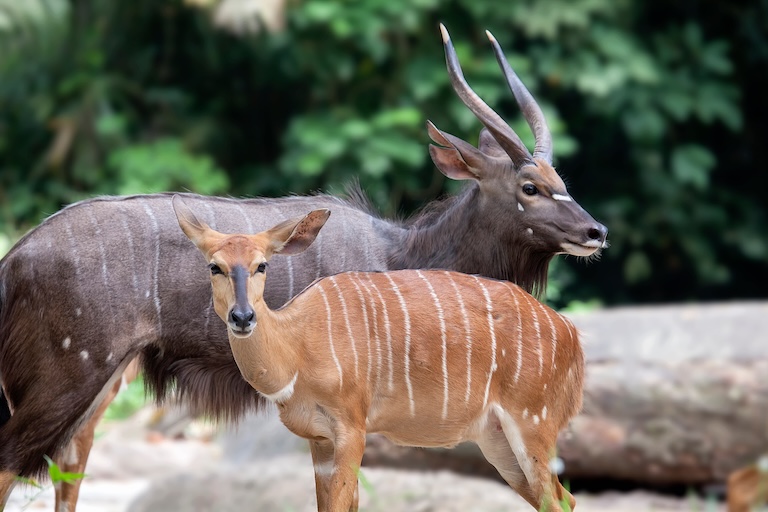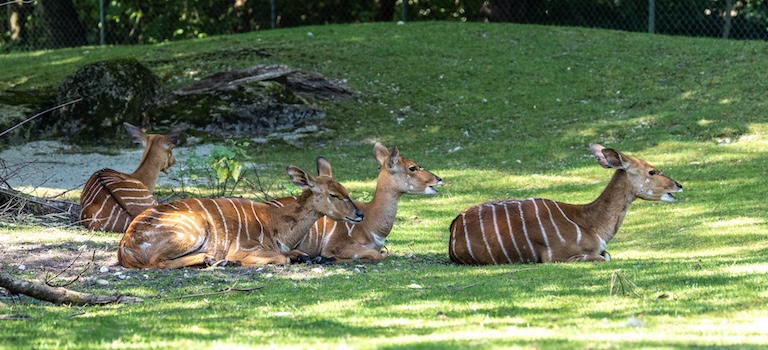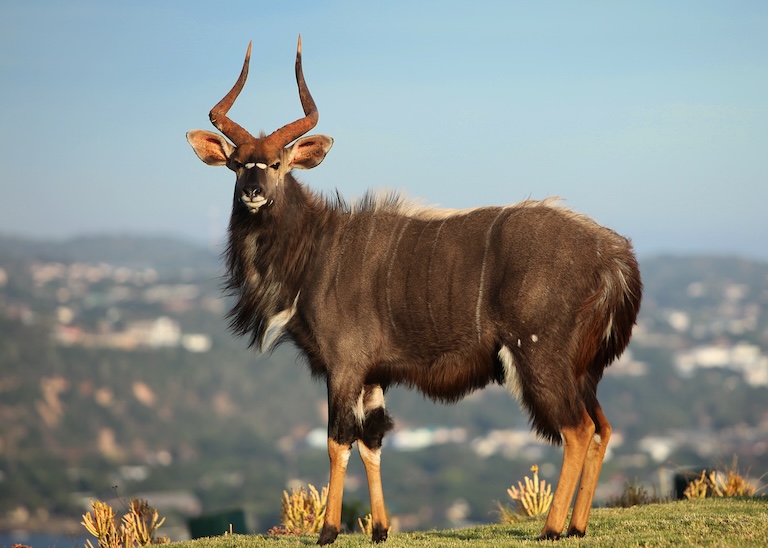Nyala Profile
The Tragalephus genus is home to some of the most beautiful antelope in Africa.
They’re mostly distinguishable by their spiral horns, vertical stripes, and a noticeable difference in size between males and females.
Of them all, the Nyala has both the sweetest name and the most punk rock hairstyle.

Nyala Facts Overview
| Habitat: | Lowland forest, Savanna, Shrubland |
| Location: | Southeastern Africa |
| Lifespan: | 19 years |
| Size: | Around 2 meters (79 inches) long |
| Weight: | Up to around 140kg (309 lb) in males, 68kg in females |
| Colour: | Golden to dark brown, males darker with white ruff and yellow legs |
| Diet: | leaves, twigs, flowers and fruits |
| Predators: | lions, hyenas, leopards, wild dogs, humans, some eagles, baboons |
| Top Speed: | Unknown |
| No. of Species: | 1 |
| Conservation Status: | Least Concern (IUCN) |
Nyala are medium-sized antelope, of the spiral horn variety. They’re not always as colourful as some of their cousins in the genus, but they have their own quirks.
Males are substantially larger than females, and this is both caused by and results in specific behaviours relating to sexual selection, social groupings and diet.
As Tragelaphus antelope, they’re not as fussy about the species with which they mate, and have been known to hybridise with exotic results. Habitat loss has reduced their range, but the species is still doing pretty well.
Interesting Nyala Facts
1. They’re spiral-horned antelope
The Tragelaphus genus gives us some of the prettiest antelope in Africa. This is the genus of the bongo, the waterbuck and the kudu. These are generally strong, mid-range deer-looking bovids, often with vertical stripes or spots, and the nyala fits right in.
Male nyala have a line of white hair along the back, giving them a bit of a mohawk, and sometimes bright yellow legs, which is one of the easiest ways to identify them. Females are much smaller and have much more vivid stripes.
Nyala lineage broke off most recently from the eland and the kudu, making them their closest relatives. Roughly five million years have separated the species since then, but as we’ll see, that doesn’t always mean a lot when it comes to romance.
2. They’re very sexually dimorphic
When 155kg Strongman and “The Mountain” Hafthor Björnsson and his 53kg wife had a baby, minds justifiably wandered to questions that would be deeply disrespectful to ask out loud.
Thankfully, we can explore this kind of mismatch in reproductive capacity in zoology and the hapless victims of such intrusive studies will never know to be upset about it.
The difference between Hafthor and his Mountain climber is an extreme example of human sexual dimorphism, something which is very common in other species. Angler fish are a great example, in which the female can be more than sixty times the length of the male.
In mammals, the difference is usually pronounced but a lot smaller. In humans, it averages 15%; that is, women are, on average, in need of two cats and a chihuahua to balance a see-saw against the average man.
In Nyalas, this difference is around 60%. This is the highest among the antelopes and the focus of investigation as a result.
3. It’s about sex
Dimorphism isn’t just related to size but to any difference in appearance. It could be colour, hairiness, tuskiness, or horniness (of the upper head variety), among others. But the differences are interesting, and tell us about how the animals live their lives.
In Nyala, the increased resource cost of gestation means that a smaller female can reduce her nutritional needs to compensate by being small.
Males, on the other hand, don’t need to spend any energy growing their offspring, so can put that surplus into being big and dominant and competing for females.
This is also why the male nyala has horns, and the female doesn’t. And the differences don’t stop there! Male and female nyalas have a different number of chromosomes, with males having 55, and females having 56. 1
4. All this affects their diets
Being such vastly different sizes, the male and female Nyalas have access to different shelves in the supermarket.
As opposed to grazers, Nyala are browsers, which means they pick and choose the best food from various heights, and in their forest habitats, this means males and females are driven to different locations to find the grub.
This is really important information when working in Nyala conservation, especially involving captive animals!

5. It also affects their herds
Food selection differs across wooded areas, and this results in a dietary-based segregation between males and females based on the food they can access.
Nyala groups can include as many as 30 antelope, usually female with young. Young females tend to stick around with their mothers for a long while, whereas young males get chased off when the mother wants to start dating again.
Males also form groups but don’t tend to know one another all that well and don’t form very strong or permanent social bonds.
When it’s time to mate, they turn on one another and use that brilliant mohawk as a display of vigour and dominance. Unlike many other antelope who show off a lot and avoid serious physical conflict, nyala males do occasionally kill one another as part of their mating routine.
Females select for larger males, and this metric appears to have no upper bound, as they’ve been known to occasionally go to extremes. Deborah Ciszek, “Tragelaphus angasii nyala”, Animal Diversity Web.[/note]
6. They sometimes breed with Kudu
Perhaps it isn’t surprising that a sexually unusual species like the nyala is prone to hybridization. But what may be surprising is that in this instance, it’s a petite female nyala with a male Greater kudu, twice the size of an average male nyala.
Then again, with the sexual selection preference of the female nyala for larger males, perhaps it isn’t at all surprising that the Kudu got some attention after all.
The resulting offspring looked a lot like a nyala and was sterile, but hybridization within this group, while uncommon, isn’t unheard of. Nyala have also been known to hybridise with bushbuck and kudu in the past. 2
7. Sometimes overgrazing can help
While the range of the nyala has been reduced by human encroachment, sometimes human presence brings with it beneficial changes to the nyala.
Moving or abandoning agricultural sites has left several premium forage areas for the browsers, as livestock have all but wiped out native grasses through overconsumption.
In their place, forbs and other nutritious browse have invaded and overpopulated, providing browsers like the Nyala a veritable vegan buffet. 3

8. They seem to be ok
There aren’t many significant threats to the species noted by the IUCN, and their population seems to be stable. They’ve repopulated to some degree within their previous range and are widespread even outside of it.
This is a refreshing change from the multitude of struggling species and bodes well for the Nyala. 4
Nyala Fact-File Summary
Scientific Classification
| Kingdom: | Animalia |
| Phylum: | Chordata |
| Class: | Mammalia |
| Order: | Artiodactyla |
| Family: | Bovidae |
| Genus: | Tragelaphus |
| Species: | Angasii |
Fact Sources & References
- Taryn Kirby (2008), “The influence of sexual dimorphism on the foraging behaviour of the nyala Tragelaphus angasii”, Research Gate.
- Desire´ L. Dalton (2014), “Interspecific hybridization between greater kudu and nyala”, NIH.
- Deon Furstenburg(2016), “NYALA (Tragelaphus angasii)”, Research Gate.
- “Nyala”, IUCN Red List.
